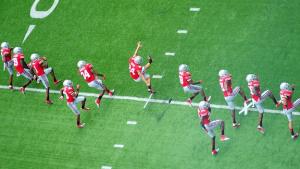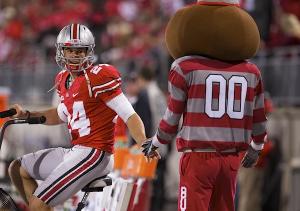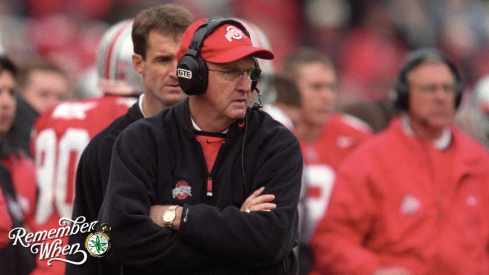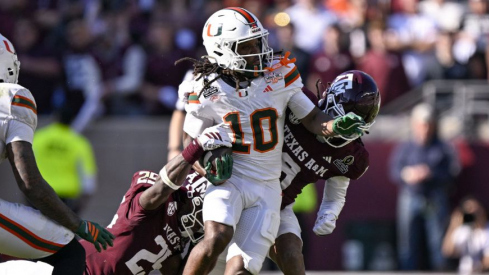Sharks remain one of the single biggest curiosities in the world. Whether you’re from the United States, South Africa or Australia, chances are you have an interest in the species of animal that humans perceive as the most vicious.
 Ready, set, go.
Ready, set, go.They’ve become such a talking point that the Discovery Channel’s “Shark Week” has aired for 25 years and gained a cult following in the process. The weeklong program is now aired in 72 countries.
But there’s an even bigger killing machine in waters of South America: piranhas.
That’s the persona the Ohio State kickoff coverage unit has taken on. Not necessarily the killing, but the swarming and takedown ability that piranhas exhibit – and smallness.
Through the first six games of the season, the unit was known as the “Sharks.” But on Sunday as cornerbacks coach Kerry Coombs, also the overseer of the coverage unit, watched film of the Buckeyes’ 63-38 win over Nebraska, he noticed that nearly every person running down to cover kicks was under 6-feet tall. Thus came the nickname “piranhas.”
“They can't be sharks yet, because they're this tall," Coombs said with his hand four to five feet off the ground. “They have to be piranhas. We like to say that when they go after a guy with the ball, it's like sharks to blood. But with this group, they're like piranhas. Just because they’re midgets.”
One drop of blood can trigger a Great White Shark’s sense of smell from three miles away. It can inhabit the blood-filled waters within minutes. Piranhas are similar, becoming agitated at the first inclination of blood nearby.
In 1913, former president Theodore Roosevelt traveled to the Amazon Rainforest and saw firsthand the fierceness of piranhas. Upon his return to the United States he wrote a book titled, “Through the Brazilian Wilderness.”
In it he referred to piranhas as “the most ferocious fish in the world. Even the most formidable fish, the sharks…usually attack things smaller than themselves. But the piranhas habitually attack things much larger than themselves…they will rend and devour alive any wounded man or beast; for blood in the water excites them to madness.”
The same can be said for the 11 Buckeyes – yes, even kicker Drew Basil – that take the field after every Ohio State score. From 65 yards away, they engage the ball carrier with a ferocity that is more grizzly than piranha.
“When they say ‘piranhas,’ it’s something that we all have to keep us together. It’s a really cool nickname that we all just take pride in,” freshman cornerback Armani Reeves said. “We’re going to play it like piranhas. We’re going to play fast, nasty and just get down the field as fast as we can.”
One thing is certain: they saw blood in the water against Nebraska. Facing one of the top kick returners in the country in Ameer Abdullah, the piranhas never let the Huskers start a drive past the Nebraska 25-yard line and three started no better than the 15.
The strategy Ohio State employed actually called for maximum hang time but no touchbacks. The goal was to stop the ball carries shy of the 15- or 20-yard line.
“We’re not the biggest guys out there compared to a lot of the other kickoff teams,” Reeves said. “But we’re fast, we’re strong and we’re hungry. And we play like that.”
Abdullah distinguished himself last season as an explosive kick returner, bringing one back all the way. He averaged nearly 30 yards per return and ranked ninth in the country. In Nebraska’s come-from-behind win two weeks ago, Abdullah averaged over 28 yards a return and gave the Huskers great field position all night.
He had 142 yards in just five kick returns against Wisconsin, while the Buckeyes limited him to 128 yards in eight returns, an average of 16 yards.
“Our kickoff team did a really good job for us,” head coach Urban Meyer said. “That was impressive. That was a very good kick returner.”
Ohio State’s kickoff return defense ranks 38th in the country. It’s allowing less than 20 yards per return with 11 touchbacks. The unquestioned leader of the group is Zach Domicone. The senior safety helped on two tackles Saturday and has four stops on the season.
“You’re talking about a senior who is surrounded by all these freshmen, and they don’t know what they don’t know,” Coombs said. “He’s starting to gather them up before they take the field. He’s trying to take some of the leadership of that group and inspire them and motivate them.”
Part of Ohio State’s success can be traced to that non-traditional strategy. With the touchback rule being changed this season – the ball is now placed at the 25-yard line – the Buckeyes have taken a different approach.
Gone are the days of bashing the ball through the end zone. Instead, the Buckeyes are giving opponents the opportunity to return a kick for a touchdown. But Basil’s orders are to put the ball high into the sky and allow his 10 piranhas the chance to run down its prey before an escape is possible.
 Brutus Buckeye approves of Drew Basil and the piranhas.
Brutus Buckeye approves of Drew Basil and the piranhas.A majority of those dependables are freshmen – Reeves, Devan Bogard, Jamal Marcus, Najee Murray, David Perkins and Camren Williams. Meyer values his special teams units, and the first step to cracking the offensive or defensive rotation is playing on special teams. It’s seen up close with Bradley Roby and Rod Smith as members of the kick coverage team.
“Coach Meyer pays a lot of attention to special teams,” Reeves said. “He really prides himself on having the best special teams in the country.”
Marcus and Adam Griffin lead the unit with six tackles apiece. The next player down the list: Drew Basil. Yes, the kicker has five tackles on the season.
“There’s no room for error,” Domicone said. “You’re not allowed to take a week off.”
Each Thursday the coverage team holds a race that is, by nature, a photo finish. In the spirit of Meyer’s appreciation of special teams, the winner is announced in a ceremony that includes the entire team. The reckless abandon that the kickoff coverage unit displays in that Thursday race spills over into Saturday.
“If we really want to go down and help our defense, it starts with us,” Domicone said. “Field position is an important part of the game, and special teams is an important part of the game. It’s a role that we’ve embraced.”
Coombs, a constant bundle of energy, cringes when he thinks about the inevitability of kickoffs no longer being a part of football. In a concussion sensitive society, kickoffs have become the ugly stepchild of football. Rule changes have occurred at the college and NFL level in recent years to help alleviate head injuries.
But until he’s told players won’t be chasing kick returners, Coombs is going to coach – and he’ll do so enthusiastically.
The Buckeyes have another challenge ahead of them this week. Indiana is 10th in the country in kickoff returns. The Hoosiers have returned one for a touchdown and average more 28 yards per return. Basil will be getting air under the ball, letting his red-bellied Buckeyes get down the field to harass the IU returner.
“They’re fun to coach,” Coombs said. “They’re not perfect and they make a lot of mistakes. But they play really, really hard. They’re going to be factors in games
“And that’s important.”

